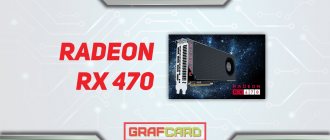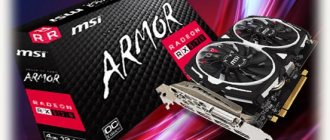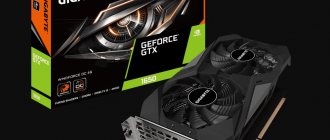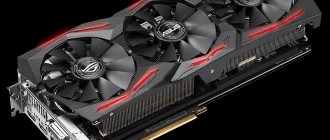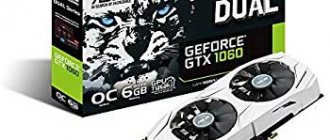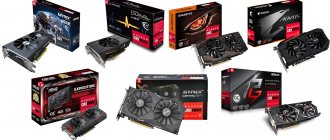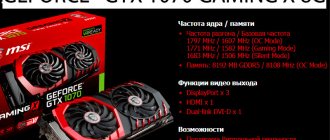Older video cards used the SDR , which had a single data transfer rate. Modern video cards use DDR or GDDR , data is transferred 2 or 4 times more data at the same frequency, so the operating frequency is multiplied by 2 or 4.
On sale you can find video cards with different types of video memory. For cheap low-end video cards, the GDDR2 and GDDR3 types are used. Such video cards are low-power and difficult to use for modern games.
What's the difference between GDDR5, GDDR5X and GDDR6
Graphics memory is an important characteristic of a video card and has a direct impact on gaming performance.
One of the most widely used memory types is still GDDR5, but it is gradually being replaced by the more advanced GDDR6.
GDDR5
GDDR5 was the fastest memory for video cards. AMD GTX 1060, GTX 1070 and RX 580 are good examples of graphics cards with GDDR5 memory on board. GDDR5 memory can deliver speeds of up to 9 Gbps, and the graphics cards came in 512 MB, 1 GB, 2 GB, 4 GB, and 8 GB capacities. GDDR5 chips are produced by different manufacturers such as Samsung, Hynix, ELPIDA or Micron.
GDDR5X
GDDR5 has a new extended version, GDDR5X. This memory is a new evolutionary step, delivering speeds of up to 14 Gbps and high bandwidth, making it an excellent choice for use in high-end graphics cards such as the GeForce GTX 1080 Ti.
GDDR6
GDDR6 memory is the latest in this standard. The voltage for GDDR6 memory is 1.3 Volts and can provide transfer speeds of up to 16 Gbps with a bandwidth of up to 72 Gbps per chip. It is produced by the same companies: Samsung, Micron and Hynix. Moreover, Samsung and Micron will provide speeds of up to 16 Gbit/s. Hynix will be occupied in the mid-range performance segment, where speeds are limited to 12-14 Gbps.
GDDR6 memory achieves performance levels similar to GDDR5X, but make no mistake, this is a completely new standard, its potential has not yet been reached and we will see much more powerful chips in the future. It is quite possible that we will reach 20 Gbit/s.
Comparison of performance and consumption between GDDR6 and GDDR5
The following table shows the most important characteristics of GDDR5 and GDDR6 memory:
| GDDR5/5X | GDDR6 | |
| Voltage | 1.5V | 1.3V |
| Manufacturer | Samsung, Micron, and Hynix | Samsung, Micron, and Hynix |
| Transmission speed | 8 Gbps GDDR514 Gbps GDDR5X | 16 Gbps |
| Format | FBGA190, 0.65 mm pitch, 14x10mm | FBGA180, 0.75 mm pitch, 14 × 12 mm |
| Configuration | X16/x32 | X8/x16 |
| Channels | 1 | 2 |
| Memory | 512 MB, 1 GB, 2 GB, 4 GB, and 8 GB | 8 GB and 16 GB |
How much memory does the video card need?
The question is very interesting. Here everything directly depends on how the video adapter will be used in terms of working with graphics. For example, if it is just an office computer, then the built-in graphics adapter will be enough for it, which itself will take up some video memory from RAM. If this is a home PC for movies and simple games, then 256 MB will be enough for it. up to 1 GB. But an avid gamer or for professional video work will need an average of 2-4 Gigabytes.
The following factors must also be taken into account:
Monitor resolution
The larger your monitor, the higher resolution it uses. And the higher the resolution is used, the more it consumes the video card memory. For example, 1 frame in FullHD quality (resolution 1920X1080X32) requires 8 MB of video memory. If you connected the most modern 4K monitor, then the resolution it uses will consume an average of 33 MB per frame.
Texture smoothing
Video smoothing generally consumes a lot of video memory. The stronger the antialiasing, the greater the VRAM consumption. In addition, different smoothing algorithms have correspondingly different consumption. Moreover, different types of anti-aliasing consume computer resources differently.
Quality of textures and shadows
The higher the quality of the textures, the more shadows of objects are displayed, the more the computer’s video memory is consumed. This is generally the strongest consumer of video card resources. Do you like to play a “heavy” game with the quality set to maximum? Be prepared for the fact that your video card may not have enough memory for this. The more realistic the picture quality, the more shadows and textures are required, which means the video adapter will be used to the maximum.
Interesting on the topic:
- How to find out what games your computer and its video card can handle
- How to combine phone memory and memory cards on Android
- Inexpensive computer for gaming - winter 2020 build
- Why is my powerful computer slow?!
- How to monitor your computer's health
- The flash drive shows 0 bytes and is not formatted
HBM2 memory
HBM 2 is the second generation of HBM memory that has all the characteristics of HBM, but with higher speed and memory bandwidth. It can have up to 8 DRAMs per stack, with transfer rates up to 2 Gbps. With a 1024-bit wide memory interface, memory bandwidth is 256 GB/s per stack, twice that of HBM memory. The total capacity of HBM2 is also larger, and it can have up to 8GB per stack. The first GPU chip to use HBM2 memory is the Nvidia Tesla P100. Nvidia's latest Pascal series graphics card for workstations, the Nvidia Quadro GP100, also features HBM2 memory. HBM2 memory will be used mainly for VR games, AR games and other applications where fast work with video memory is needed.
GPU architectures supported by HBM2 include Vega, Pascal, and Nvidia's latest Volta GPU architecture. The successor to HBM2 is HBM3, which will be released in 2022. Top graphics cards using HBM2 memory: Nvidia Titan V, Radeon Vega Frontier Edition, Radeon RX Vega 56, Radeon Vega RX 64, Nvidia Quadro GP100.
How to increase the video memory of discrete cards by increasing performance
First, let's look at the question of how to increase the video memory of a discrete video card. Ideally, of course, the easiest way is to buy a new one, but modern adapters are very expensive, so it’s better to set up what you have.
Based on the fact that today the market offers mainly NVIDIA and AMD/ATI chips, it is worth using the accompanying software, which comes pre-installed when purchasing a PC or laptop.
Also, for Windows systems, in terms of improving performance, utilities like ATITool or MSI Afterburner are perfect, which allow you to gradually increase the clock frequency of the GPU, leaving the memory indicator unchanged.
In addition, you can use programs like Catalyst, PhysX or Riva Tuner, which can optimize the video chip's memory for use in certain games or other applications, freeing up resources.
History of the development of memory standards
DDR2 memory was used in the NVIDIA GeForce FX 5800 Ultra video card. Although the memory was somewhere between DDR and DDR2.
GDDR3 memory was designed specifically for video cards; it had the same characteristics as DDR2, but with reduced consumption and heat dissipation, this made it possible to design boards with higher operating frequencies. This means that productivity has increased and the cooling system has been simplified.
DDR3 first installed on the modified NVIDIA GeForce FX 5700 Ultra, and then on the GeForce 6800 Ultra. Although the standard was developed by ATI engineers together with JEDEC, it was first used by nVidia. ATI itself began using this type of memory in the Radeon X800 series. GDDR3 was also used in the PlayStation 3 and Xbox 360 game consoles
GDDR4 was almost 2 times faster than the previous GDDR3. Technically, it was not very different from GDDR3. The main features were that GDDR4 had increased operating frequencies and reduced power consumption - about three times less than GDDR3.
ATI RADEON X1950 XTX became the first video card to have GDDR4 chips installed. The memory was not particularly popular; it was discontinued and replaced by GDDR5.
GDDR5 is the fastest type of video memory used in high-end video cards, operating at quadruple frequency up to 5 GHz (though theoretically up to 7 GHz). This made it possible to increase throughput to 120 GB/s when using a 256-bit interface. For example: to increase the bandwidth of GDDR3 or GDDR4 memory, it was necessary to use a 512-bit wide bus. With GDDR5, performance is doubled, with a smaller chip size and less power consumption.
Development of video card memory
| GDDR | GDDR2 | GDDR3 | GDDR4 | GDDR5 | ||||
| Nvidia | ATI | |||||||
| Year of mass release | 2001 | 2003 | 2004 | 2006 | 2006 | 2008 | ||
| Max. Frequency | 200 MHz | 500 MHz | 900 MHz | 1.2 GHz | 1.4 GHz | 5 GHz | ||
| Configuration | 4 Mx32 | 4 Mx32 | 8 Mx32 | 8 Mx32 | 16Mx32 | 32Mx32 | ||
| Buffer width | 2n | 4n | 4n | 4n | 8n | 8n | ||
| Voltage | 2.5V | 2.5V | 1.8V | 1.8V | 1.8V | 1.5V | ||
What is computer graphics video memory?
I think you already understand that in addition to the main RAM, a computer or laptop also has video memory - VRAM . The abbreviation stands for Video Random Access Memory. Graphic video memory of a computer video card is a special type of RAM that is used in discrete video adapters in computers and laptops. It is made in the form of chips soldered on the video card board around the graphics processor.
I think it’s clear that the more modules are soldered, the larger the amount of video memory. A logical question arises here: why is it needed, since the computer already has RAM! The video card memory is used for temporary storage of graphic data - namely, images (the so-called frame buffer) - generated and transmitted by the video adapter to the PC monitor. The video memory is dual-port, meaning it can simultaneously write data when the image changes and at the same time read its contents to draw the image on the screen. Simply put, the video card memory supplies the GPU with the data it needs to render the image - called rendering. This data includes the frame buffer, shadow map, textures used, lighting, and so on.
How to find out the amount of video memory
You can determine the amount of video memory of the video adapter installed on your computer in several ways.
Firstly, knowing the exact model of the video card, you can find out absolutely everything about it on the Internet by entering the model index into a search engine.
Secondly, you can use one of the many utilities that display all the information about the computer’s video adapter. For example, Everest, Aida64 or HWiNFO64. For example, I like the free GPU-Z program best:
Fast, easy and shows absolutely all the necessary information. Memory Type field Memory Size field will show its volume.
Thirdly, you can find out the amount of memory in the sticker that is usually glued to the video adapter. It contains the device model, the chip used and the installed video memory size. However, to use this method, you will have to disassemble your computer. With laptops in general, this is a wild inconvenience!
How to increase video card memory
This question is usually asked by beginners. They know that the amount of RAM on a computer can be expanded by installing additional modules and they think that everything is exactly the same with a video card. But no, you won’t be able to increase the amount of video memory without replacing the video card. To do this, you need to buy a new adapter and replace the old one with it.
By the way, in my practice there was a case when an experienced radio technician was eager to resolder RAM modules from one board to another. Moreover, there were corresponding places on the board for this. But this venture did not end in anything. Not only do such works have a high level of accuracy, but even if it is possible to physically increase the amount of video memory, you will also need to reflash the device itself. After all, without the appropriate software, the board will still not see the installed RAM modules.
High Bandwidth Memory
High Bandwidth Memory takes memory subsystem parameters to a new level. With its 1024-bit interface (per chip, for the R9 Fury X a total of 4096 bits), it is twice the bus width of GDDR5. Two important innovations enable this to be achieved: Through-Silicon Vertical Interconnect Access (TSV) and the interposer (silicon substrate).
The first generation HVM chip combines four layers of video memory chips in a small area. In graphics cards like AMD's Fury X, it connects directly to the GPU. This reduces power consumption and at the same time improves the overall performance of the card.
In High Bandwidth Memory, bits of information stored in memory cells pass through TSV to the logic layer. It outputs data through an interposer to the GPU or display devices.
TSVs are small data lines routed through layers of stacked chips. Each layer consists of several layers in which individual video memory cells are grouped. For TSV, small holes with a diameter of about 10 microns are etched into the silicon and, after applying a protective oxide layer, filled with copper.
This approach has been practiced as a concept or in 3D chip prototypes for a long time, but now it is being used for the first time in a production product. 1024 TSV lines pass through the HBM stacks vertically from top to bottom through all four layers. On the board they are distributed over eight channels - each 128 bits wide. TSVs end in small contacts (microbumps) that connect the memory chips to the control logic.
All ways, no other
How to increase video memory? At the moment there are no other options to increase the volume other than those described in this article. In any case, it is better to replace components rather than improve them. As a bonus, we can advise you to properly configure the video card of your iron friend. It’s not for nothing that all the experts say that assembling a computer is always cheaper than buying a new one. However, it is best to collect if you have experience. There is no need to touch on areas where specialized knowledge in architecture or computer programming is required. Sometimes technical issues should be left to specialists.
Cooling system
It is this component (a huge radiator, several fans) that catches your eye when you first look at the video card. The only exception is, perhaps, budget low-power graphics adapters, which make do with cooling systems that are modest in size and weight.
If we are talking about something like RTX 2060/3060 or AMD 6700 and higher, then the cooling system will inspire respect, at least with its weight.
The radiator is a rather intricate piece of hardware with a large number of thin lamellas, consisting of several sections and heat-dissipating plates in contact with the graphics processor, memory chips and power elements of the power supply system.
Almost all manufacturers install multiple heat pipes to increase the efficiency of the radiator.
The heat pipe is metal (often copper, can be coated with nickel), sealed, with an easily evaporating liquid inside. This liquid evaporates where one end of the tube touches the hot element, after which the vapor condenses at the opposite, cold end, after which the liquid returns to the hot end of the tube.
Most often, heat pipes are used with porous inner walls, through which liquid, under the influence of capillary forces, moves to the evaporation zone, regardless of the position of the tube itself in space. This liquid can be water, ammonia, ethanol, etc.
There is also such an element as an evaporation chamber. This is a kind of modernization of the idea of a heat pipe, using the same principle of liquid evaporation, which removes heat from the cooled element. The difference is that the flat sandwich construction increases the efficiency of this process.
The number and configuration of tubes varies among different manufacturers. Some of them can be used for contact with the GPU, and an individual tube is installed for elements of the power system. "Direct contact" technology can be used, where the heat pipes are in direct contact with the GPU. This allows for improved heat transfer.
However, it is not enough to simply pick up heat in one way or another - a heat pipe and/or a radiator; this heat must be put somewhere else. For this purpose, a fan(s) is used.
A few years ago, NVidia and AMD reference video cards used a turbine cooling system. Its essence is that only one radial fan is installed, which takes air from the case and drives it through the entire video card, throwing it out.
A radiator with a large number of fins is installed under the video card casing. The main disadvantage of such a cooling system is noise. The only fan is small in size, and to ensure the required air flow it has to rotate at high speed. And the higher it is, the higher the noise.
Both manufacturers abandoned the turbine system, starting with the NVidia RTX 2000 and AMD RX 6000 families of video cards. Preference is given to more conventional axial fans, of which there can be from one to several, depending on the size of the video card and the “hotness” of its character.
The MSI GeForce RTX 3070 Ti Suprim X reviewed today has three fans with a diameter of 95 mm each. Their maximum rotation speed is 3,250 rpm, but you have to work hard to get the wind turbines to reach such speeds. In reality, even under maximum load they rotate at lower speeds, and when the graphics chip temperature is below 60°C they stop altogether.
Some manufacturers use the opposite direction of fan rotation. If there are two of them, then one rotates clockwise, the other counterclockwise. With three fans, the middle one usually has the opposite direction of rotation compared to the outer ones. Manufacturers claim that in this way it is possible to combat air flow turbulence and improve radiator airflow.
Rare video card models can be equipped with one or two additional small fans. For example, INNO3D GeForce RTX 3070 ICHILL X4 has a small fan on the top edge that blows the heat pipe with the heatsink from the VRM circuits.
An alternative to standard cooling systems can be liquid cooling, which you can install yourself, or the manufacturer initially offers a modification of the video card with a mounted coolant radiator. It is not fundamentally different from that used for the CPU, but there are some differences. The problem is that in addition to the graphics chip, it is also necessary to cool the video memory chips and VRM circuits, which makes the heat sink quite complex in design.
A protective panel that covers the back side of the printed circuit board can also be a useful thing. At a minimum, it protects the board from possible damage, improves the mechanical strength of the video card, and often also participates in cooling, for which it contacts the printed circuit board through thermal pads at the installation site of, say, the power elements of the power supply system.
Interface connector for connecting to the motherboard
All latest generation video cards use the PCI-Express interface. Recent generations have switched to version 4, although they work without problems in older versions, for example, PCIe 3.0.
Video cards receive 16 interface lines from the processor. Depending on the CPU, the number of these lines and the interface version may differ. The latest generations of AMD Ryzen processors and Intel “stones” can fully provide the video card with these “tracks” for data delivery.
If for some reason it is not possible to provide the video card with all 16 lines (for example, the second PCIe slot on the motherboard is connected to the processor, and it is used for some controller) and it only has half left, then... nothing bad will happen . The video card will work fine and it is unlikely that you will notice any changes at all.
Power connector(s)
But the PCIe connector is not only responsible for data transfer. Through it, power is supplied to the video card. And everything would be fine, but there is a problem. It is not able to provide normal power to even the youngest video card model in the line. Why?
Let's take a look at the illustration showing part of the PCIe connector, or rather the short part up to the jumper. There are 22 contacts, some are used for service needs, and some are used to supply voltages of 12 V and 3.3 V.
In total we have five 12-volt pins and three with a voltage of 3.3 V. According to the specifications for PCIe, the maximum current for a voltage of 3.3 V is 3 A, and 5.5 A for a voltage of 12 V. Calculating the maximum power is now simple:
(5.5 (A) * 12 (V)) + (3 (A) * 3.3 (V)) = 75.9 W
Now remember that for the RTX 3060 the maximum power consumption is specified as 170 W, which is more than double the PCIe interface. Where can I get additional power? Directly from the power supply.
To do this, video cards have from one to three connectors (with six or eight pins) for connecting the cable/s from the power supply. And we shouldn’t forget about this. Your PC's power supply must provide the required number of connectors.
Interface connectors for connecting a monitor/s
All these chips, radiators, fans are all good, but where do you connect the monitor to see something? Use the connectors that are located on the rear end of the video card. In the vast majority of cases, on modern video cards you will find one or two HDMIs and a couple of DisplayPorts.
Actually, this is where you connect it, depending on what interface your monitor has. Or several, since no one prohibits the use of more than one display means. Some video card models also have a USB Type-C connector, but this is for specific needs.
Connector for combining video cards in SLI or CrossFire mode
Several years ago, the topic of combining multiple video cards to work together to improve performance was very popular. NVidia introduced SLI technology, AMD's analogue is called CrossFire.
Now it has become less interesting, because this mode of operation did not really meet expectations. The cost of purchasing two or three video cards does not justify the resulting performance increase.
It is not surprising that the 3000 series of video cards from NVidia have limited support for SLI. I would say that quite a few models allow you to use them in this way.
But video cards, for example, the 1000 series, have such support. To use SLI technology, the video card must have a special connector on the top edge.
The illustration shows such a connector for the Gigabyte GeForce GTX 1070 G1 Gaming video card. To combine two graphics adapters, you need to use a special jumper that is installed in this connector.
I repeat that most modern video card models do not support this functionality.
What else?
I do not dwell in detail on the auxiliary functions of video cards. This may include backlight control, the presence of a small display for displaying service information or custom images.
Is it worth mentioning the presence of a switch for selecting one of the video card operating modes. Their latest generations initially have two BIOSes. The first is focused on quiet operation, which is achieved by reducing the GPU operating frequency and fan speed. The second is a sort of “sport mode” that reveals all the capabilities of the video card.
Well, almost everything, because the user can also independently set the operating modes of the video card and do overclocking.
Old tests
The test was tested on different games at the highest graphics quality settings:
- Battlefield Bad Company 2
- Call of Duty Modern Warfare 2
- Crysis Warhead
- Grand Theft Auto 4 EFLC
- Mass Effect 2
- Metro 2033
- STALKER Call of Pripyat
- and others.
As a result, the following values were obtained:
Video memory usage in various games, MB
| DirectX 9 | DirectX 10 | DirectX 11 | |
| 1680x1050 | 402-1104 | 450-993 | 721-1016 |
| 1920x1200 | 424-1137 | 518-1097 | 784-1034 |
| 2560x1600 | 733-1536 | 737-1536 | 1030-1536 |
The most demanding game, as always, remains Crysis Warhead , as well as Napoleon Total War, the game even surpassed Crysis.
What is affected by the amount of memory on a video card?
As noted earlier, in some cases, increasing the amount of memory on a video card does not improve its performance. You need to understand that memory is a storage from which data is taken for processing by the GPU (graphics processor of the video card) and if the GPU is weak, then no matter how much memory is increased, performance will not increase. Of course, the bus width and memory type also influence, but the GPU is still more important.
This is not difficult to check on identical video card models, but with different amounts of video memory.
The test used identical video cards from the same manufacturer, but with different amounts of memory. Only in the case of the Radeon HD 4870 is there an increase in performance.
HyperMemory technology (for ATI ) and TurboCache (for NVIDIA ), if necessary, the video card can use additional memory from RAM. In this regard, some programs indicate the incorrect value of the video card memory (even standard Windows utilities). To check, it is best to use the CPU-Z program; it determines the physical volume of the video card, and not expanded due to TurboCache or HyperMemory .
How to find out the memory type of a video card?
To determine the type of video memory, you will need to use special online services or third-party applications, free versions of which can be easily downloaded from the Internet. The most popular and convenient among them are the following programs:
TechPowerUp GPU-Z
An easy and simple program that doesn't even require installation. It is enough to download a small file, by running which you can make a choice - to install the application completely or immediately launch its simplified version and start using it right away.
• Go to the developer’s website https://gpuz.site/ and download the program;
• Launch it and you will see a small menu that will contain many characteristics;
• The “Memory Type” item will indicate the type of video memory of your video card.
It is worth noting that if your device has several video adapters, then you can switch between the characteristics of all devices. To do this, there is a corresponding block at the very bottom of the program menu.
AIDA64
Another useful multifunctional program, one of the main functions of which is to determine the type of video memory:
- Go to the developer’s website https://www.aida64.com/ and download the program;
- Launch it and select “Display” in the left corner;
- Go to the “GPU” submenu;
- A list of all the characteristics of your video adapter will open, among which there will be an item called “Bus type”. It contains a description of the type of video memory.
One at the expense of the other
You can try to solve the problem of how to increase video memory using RAM. First, make sure that the installed modules have enough capacity to transfer some megabytes to video. You can call this method of increasing memory capacity without cost.
Let's try to implement step by step the intention to increase the RAM of a laptop or computer.
- Step number one. We take our laptop and go to the store, we explain to the seller that we want to install a new memory slot.
- Step two. Without much fanaticism, we insert a module into the slot; if we select second-generation memory, but it is not inserted, it means that the equipment has third-generation memory. Remember: when connecting the RAM, you should not be zealous, because you can damage the device!
- And the third step. If we have tried all the modules that the seller showed, then we can be congratulated - we have a rather rare energy-saving RAM (1.35 volts). In ordinary laptops, RAM is designed for one and a half volts.
How much memory can be inserted into a laptop can be found in the manual or on the manufacturer’s official website. It should indicate the number of gigabytes, as well as what generation of memory you will need to look for in stores.
